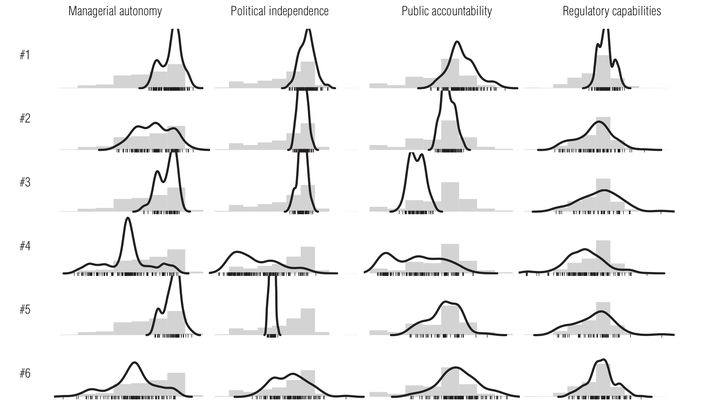Agency proliferation and the globalization of the regulatory state: Introducing a data set on the institutional features of regulatory agencies
 Distribution of agency scores in each cluster.
Distribution of agency scores in each cluster.
Abstract
State structures have experienced significant transformation with the spread of globalization. This paper examines how to measure one major change that has occurred in recent decades: the worldwide proliferation of public agencies with regulatory tasks. It remains unclear how their configurations vary across countries and sectors, and what can be learned from these variations. To better identify these agencies worldwide, we introduce a new dataset on the institutional features of 799 agencies in 115 countries and 17 policy sectors. The dataset contains variables from their institutional profiles, covering a broad range of formal characteristics. To examine the diverse faces the regulatory state has adopted along its globalization path in depth, our variables are grouped into four blocs: regulatory responsibilities, managerial autonomy, political independence, and public accountability. As such, we depart from the view that a single dimension does capture the actual diversity of institutional forms regulatory agencies may exhibit. We also use factor and cluster analyses to assess their various forms, and suggest a typology of agency institutional models to facilitate more precise studies on the regulatory state. Results confirm that the regulatory state shows greater variety than usually expected.
Regulation & Governance published the article “Agency proliferation and the globalization of the regulatory state: Introducing a data set on the institutional features of regulatory agencies” on December 2018. The article is based on an inedit dataset with data collected and referring to 2010. This is the accompanying digital page which provides the dataset and more comprehensive information about the collected data.
This paper is on the journal’s top downloaded recent papers (June 2019).
Codebook
The codebook contains a detailed description of the creation of the database, including criteria for the definition of the units of analysis, the coverage by countries and sectors, and the description of each of the raw variables collected.
Online appendix
The online appendix contains an extension of the procedures and results presented in the paper, with descriptives figures of the dataset, details about the machine learning algorithm to perform the cluster analysis, the code for the mixed factor analysis, and classifications of countries and sectors based on the means of their agencies.
Data
Recall from the article that the score represents the position of the institution in a dimension in 2010. It is a normalized value with mean zero and standard deviation one, and, therefore, it measures how many standard deviations away from the mean of all the agencies is located the agency at hand. The score comes from a posterior distribution of a parameter of a mixed factor analysis. Its value as a single point estimate is the fifth percentile of such posterior distribution (this loss function penalizes cases with missing data).
Discover the institutional features of regulatory agencies through a webpage that allows you to inspect, filter and sort the data.
The data is also downloadable in long and wide formats, both containing the same information:
- Long: every entry is an institution and a dimension (csv, 227 Kb).
- Wide: every entry is an institution, and the columns are the four dimensions (csv, 51 Kb).
Data visualization
- Dimensions (identify cases): identify the regulatory agencies comparing one-by-one each of the four dimensions.
- Dimensions (explore clusters): explore the distribution of agencies in each cluster.
- Countries: locate the regulatory agencies covering each country, compared with the rest of the sample.
- Sectors: locate the regulatory agencies covering each sector, compared with the rest of the sample.
You can also browse a PDF report with static figures that describe the dataset.
Data processing
There is a tutorial on process the dataset of institutional characteristics of regulatory agencies in R.
Citation
When citing the dataset, please use the following:
Jordana, J., Fernández-i-Marín, X. and Bianculli, A. C. (2018), Agency proliferation and the globalization of the regulatory state: Introducing a data set on the institutional features of regulatory agencies. Regulation & Governance. Vol 12, Issue 4, 524-540. doi:10.1111/rego.12189.